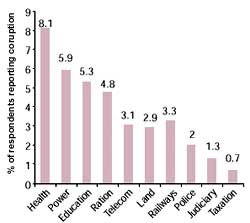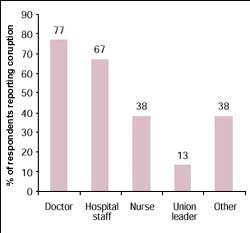A study done in over 10 sectors of India shows that India pays 267 billion rupees
bribe, with health and education sectors being the most corrupt. The survey is about the
outflow of corruption and not an index of corruption levels.
Transparency International, a non governmental organisation (NGO) along with ORG MARG
– a professional marketing and research organisation, conducted an All India survey
to assess the presence and extent of corruption in various sectors of public domain and
its impact on people. In all, 5157 people were interviewed all across the country and it
covered sectors like education, police, health, land administration, judiciary, power,
taxation, railways, telecom and ration. Though the police sector has been found to be the
most corrupt sector, when seen in terms of the basis of actual experience, it is the
health sector, which is most corrupt. A total of Rs. 7578 crores was paid as a bribe in
the health sector by 25 per cent of the surveyed population. Bribing for getting admission
to hospitals lead with non-proper care by doctors and nurses and also in terms of non
proper supply of medicine, food etc. Payment to staff to gain admission to hospital is the
most common corrupt practice in health care. Such payments are higher in southern India.
"The key actors leading to corruption in this sector across zones are allegedly
doctors (77%) followed closely by hospital staff (67%)," says the report. Lack of
accountability and monopoly power were cited as the main reason for corruption. Nearly 23
per cent of the respondents felt that shortage of essential resources breed corruption.
Sectorwise outflow of coruption |
Major
actors in corruption in the health sector |
 |

|
The report revealed that there is a very high correlation between Corruption Perception
Index (CPI) and Human Development Index (HDI). Countries, which are more corrupt, are less
developed. According to the CPI, India ranks 71st among 102 countries that were covered in
2002. Though CPI is not based on hard data, it does help in identifying areas that need to
be strengthened in terms of proper delivery and implementation.
Says R H Tahiliani, chief, Transparency International India, "These revelations
are a cause for concern because nearly two-thirds of the 19.3 million public servants are
involved in the 10 sectors. The impression that health and education are the two most
corrupt areas arose because more people have of necessity to interact with the health and
education sectors than say with the police, PDS, or railways. The share of health and
education from the total amount of money paid as bribes by people - a staggering Rs 26,728
crore — is therefore much higher."
References:
Corruption in India – an empirical study 2002, Transparency International India and
ORG-MARG Research Private Limited, December 17, New Delhi, pp 46.
|

